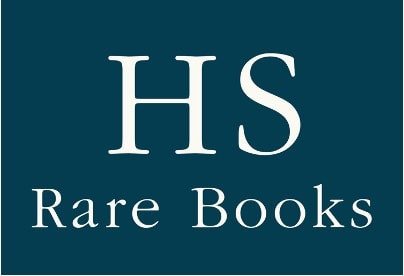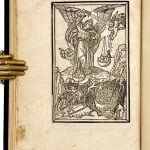![[Illustrated incunable Ars Moriendi], Ars moriendi ex varijs scripturarum sententiis collecta/cu(m) figuris ad resistendii in mortis agone dyabolice sugestioni, S.a. [1495/98]. Leipzig. Conrad Kachelofen.](https://artlogic-res.cloudinary.com/w_1600,h_1600,c_limit,f_auto,fl_lossy,q_auto/artlogicstorage/hsrarebooks/images/view/185040dcc178b0344d61c55831d2daf2j/hsrarebooks-illustrated-incunable-ars-moriendi-ars-moriendi-ex-varijs-scripturarum-sententiis-collecta-cu-m-figuris-ad-resistendii-in-mortis-agone-dyabolice-sugestioni-s.a.-1495-98.jpg)
![[Illustrated incunable Ars Moriendi], Ars moriendi ex varijs scripturarum sententiis collecta/cu(m) figuris ad resistendii in mortis agone dyabolice sugestioni, S.a. [1495/98]. Leipzig. Conrad Kachelofen.](https://artlogic-res.cloudinary.com/w_1600,h_1600,c_limit,f_auto,fl_lossy,q_auto/artlogicstorage/hsrarebooks/images/view/4febead7abcaadeaeea9eefa33bb7e25j/hsrarebooks-illustrated-incunable-ars-moriendi-ars-moriendi-ex-varijs-scripturarum-sententiis-collecta-cu-m-figuris-ad-resistendii-in-mortis-agone-dyabolice-sugestioni-s.a.-1495-98.jpg)
![[Illustrated incunable Ars Moriendi], Ars moriendi ex varijs scripturarum sententiis collecta/cu(m) figuris ad resistendii in mortis agone dyabolice sugestioni, S.a. [1495/98]. Leipzig. Conrad Kachelofen.](https://artlogic-res.cloudinary.com/w_1600,h_1600,c_limit,f_auto,fl_lossy,q_auto/artlogicstorage/hsrarebooks/images/view/edb26202fbab7efaf2eee8590e69f82fj/hsrarebooks-illustrated-incunable-ars-moriendi-ars-moriendi-ex-varijs-scripturarum-sententiis-collecta-cu-m-figuris-ad-resistendii-in-mortis-agone-dyabolice-sugestioni-s.a.-1495-98.jpg)
![[Illustrated incunable Ars Moriendi], Ars moriendi ex varijs scripturarum sententiis collecta/cu(m) figuris ad resistendii in mortis agone dyabolice sugestioni, S.a. [1495/98]. Leipzig. Conrad Kachelofen.](https://artlogic-res.cloudinary.com/w_1600,h_1600,c_limit,f_auto,fl_lossy,q_auto/artlogicstorage/hsrarebooks/images/view/5d99b94083e9710ec5193e677a1f1ce8j/hsrarebooks-illustrated-incunable-ars-moriendi-ars-moriendi-ex-varijs-scripturarum-sententiis-collecta-cu-m-figuris-ad-resistendii-in-mortis-agone-dyabolice-sugestioni-s.a.-1495-98.jpg)
![[Illustrated incunable Ars Moriendi], Ars moriendi ex varijs scripturarum sententiis collecta/cu(m) figuris ad resistendii in mortis agone dyabolice sugestioni, S.a. [1495/98]. Leipzig. Conrad Kachelofen.](https://artlogic-res.cloudinary.com/w_1600,h_1600,c_limit,f_auto,fl_lossy,q_auto/artlogicstorage/hsrarebooks/images/view/f92f35aa89cd7fcda6e8c49ec738f289j/hsrarebooks-illustrated-incunable-ars-moriendi-ars-moriendi-ex-varijs-scripturarum-sententiis-collecta-cu-m-figuris-ad-resistendii-in-mortis-agone-dyabolice-sugestioni-s.a.-1495-98.jpg)
[Illustrated incunable Ars Moriendi]
Fascinating illustrated incunable Ars Moriendi, or Art of Dying, with a wonderful and rarely seen striking set of woodcuts, a medieval best seller, and one of the great themes of medieval life, inspired in the woodblock books. As with all early editions, this edition is rare. This is a very fine, nearly uncut copy of the Ars Moriendi, which comes from two of the greatest English libraries of the 20th century.
Further images
4to, (206 x 154 mm). 14 ff. including 14 full-page woodcuts after the block book illustrations (A8 B6). Modern binding of old(?) wooden boards covered with black silk, vertically patterned. Nearly uncut copy, faint stains on some margins, last leaf with a small restoration at the lower edge. Some contemporary annotations to three pages, leaf B2 2mm smaller at the bottom, obviously delivered like that by the printer. All the woodcuts in very sharp impressions.
The illustration:
The incunable editions of the Ars Moriendi follow the same subjects, although they vary in their maker and appearance, as they are reinterpretations of the illustrations which probably originated in the drawings from the school of Rogier van der Weyden, now lost, which served as the models for the engravings of the several blockbook editions, and for typographic editions illustrated by woodcuts, produced throughout Europe in the late 15th and early 16th centuries. One of these important groups of re-interpretations is the set of woodcuts made for a series of editions printed in Leipzig in the 1490s by Konrad Kachelofen. This set consists of fourteen full-page woodcuts, eleven of which are directly inspired by Master E. S. blockbook prints; the other three are from other anonymous sources. Kachelofen's series of Ars moriendi cuts was the most widely distributed in the 15th century, he issued five editions in Latin and three German, all undated, the later included only thirteen cuts, while the Latin editions included the full suite of fourteen.
The Lyon and overall French editions, for example, contain less dramatic images than the ones that illustrate our edition, by Kachelofen; by the 1500, Melchior Lotter published another Ars Moriendi, with illustrations that resemble this, however are not exactly the same.
The body of illustrations represent the confession (not included in the German editions), the dying man receiving the Viaticum (Eucharist for dying men), the 11 remaining images evoke the five temptations from evil, the five angelic inspirations and the good death, Saint Michael weighing the souls.
The text:
The Ars moriendi was one of the great texts and themes of medieval life, and its most poetic expression was found in a series of wonderful images created in the mid-15th Century Netherlands by Rogier van der Weyden, this series is now lost. The text was created at the beginning of the 15th century in Germany as Tractatus artis bene moriendi probably around the Council of Constance, the text was abridged in the Netherlands, more directed towards the temptations assailing dying men, and the means of resisting temptation
The drawings, as aforementioned, served as models for the Master E.S. blockbook editions, and for the woodcut editions.
“Ars moriendi, or The Art of Dying is an important genre of book which reveals the medieval Church rituals surrounding the last rites of a dying Christian. The earliest known printing of the Ars moriendi is a block book edition produced in the southern Netherlands around 1450, though this date is still under debate by historians of the subject. By 1500, over eighty printed editions were produced from presses in Germany, France, Italy, the Low Countries, Spain and Great Britain. Hind wrote that its popularity probably comes from the fact that its was intended as a guide to clergy in giving comfort and counsel to the dying.” (LoC catalogue entry for their copy of the block book, which contains different images, all following the same subjects, and quite similar though evidently by different hands).
“Most printed editions of Ars moriendi follow a standard format. The first two woodcuts represent the sacraments of confession and extreme unction, events critical to the salvation of the soul of the dying man. They are followed by ten full-page cuts, issued in pairs, one illustrating man´s struggle with temptation and the other depicting the intervention of angels and the saints to help the person to resist. The final two woodcuts illustrate the triumph of salvation through grace at the hour of death and the role of Saint Michael in determining, by the scale of justice, the disposition of the soul at death.
“Determining the original sources for these images is a matter of debate. Some historians suggest that the woodcuts are based on illuminations from the medieval manuscript tradition, while others contend that the source of the engraver known as the Master ES, active in the Upper Rhineland from about 1450 to 1467, these differences of opinion go to the heart of the question of attribution, where date, place, and authorship are extremely difficult issues to resolve for work done during the late medieval and early Renaissance period.” (Daniel de Simone, ed., A Heavenly Craft the woodcut in early printed books, 2004, George Braziller, inc., New York, p.87).
GW 2577. Hain 1834. Voulliéme: Berlin 1844. ISTC ia01118000; Proctor, 2924.
Provenance: this is the copy of two of the most important English collectors of the 20th century: Charles Dyson Perrins (sale III, 1947, lot 550: £ 380/-/-, a huge price) and Hermann Marx (exlibris, not in his 1948 sale).
Join our mailing list
* denotes required fields
We will process the personal data you have supplied in accordance with our privacy policy (available on request). You can unsubscribe or change your preferences at any time by clicking the link in our emails.





